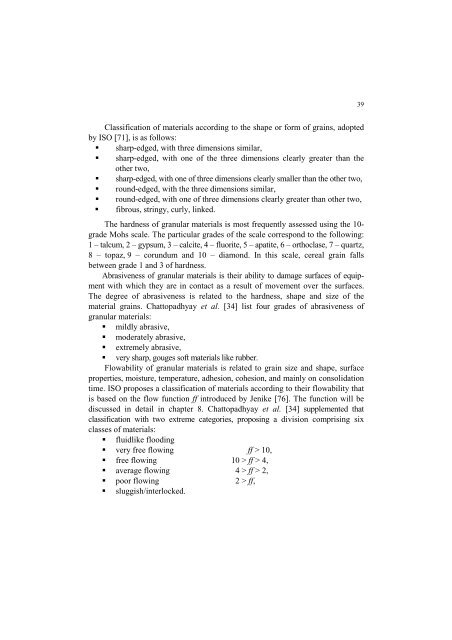Strona 2_redak - Instytut Agrofizyki im. Bohdana DobrzaÅskiego ...
Strona 2_redak - Instytut Agrofizyki im. Bohdana DobrzaÅskiego ...
Strona 2_redak - Instytut Agrofizyki im. Bohdana DobrzaÅskiego ...
Create successful ePaper yourself
Turn your PDF publications into a flip-book with our unique Google optimized e-Paper software.
39<br />
Classification of materials according to the shape or form of grains, adopted<br />
by ISO [71], is as follows:<br />
sharp-edged, with three d<strong>im</strong>ensions s<strong>im</strong>ilar,<br />
sharp-edged, with one of the three d<strong>im</strong>ensions clearly greater than the<br />
other two,<br />
sharp-edged, with one of three d<strong>im</strong>ensions clearly smaller than the other two,<br />
round-edged, with the three d<strong>im</strong>ensions s<strong>im</strong>ilar,<br />
round-edged, with one of three d<strong>im</strong>ensions clearly greater than other two,<br />
fibrous, stringy, curly, linked.<br />
The hardness of granular materials is most frequently assessed using the 10-<br />
grade Mohs scale. The particular grades of the scale correspond to the following:<br />
1 – talcum, 2 – gypsum, 3 – calcite, 4 – fluorite, 5 – apatite, 6 – orthoclase, 7 – quartz,<br />
8 – topaz, 9 – corundum and 10 – diamond. In this scale, cereal grain falls<br />
between grade 1 and 3 of hardness.<br />
Abrasiveness of granular materials is their ability to damage surfaces of equipment<br />
with which they are in contact as a result of movement over the surfaces.<br />
The degree of abrasiveness is related to the hardness, shape and size of the<br />
material grains. Chattopadhyay et al. [34] list four grades of abrasiveness of<br />
granular materials:<br />
mildly abrasive,<br />
moderately abrasive,<br />
extremely abrasive,<br />
very sharp, gouges soft materials like rubber.<br />
Flowability of granular materials is related to grain size and shape, surface<br />
properties, moisture, temperature, adhesion, cohesion, and mainly on consolidation<br />
t<strong>im</strong>e. ISO proposes a classification of materials according to their flowability that<br />
is based on the flow function ff introduced by Jenike [76]. The function will be<br />
discussed in detail in chapter 8. Chattopadhyay et al. [34] supplemented that<br />
classification with two extreme categories, proposing a division comprising six<br />
classes of materials:<br />
fluidlike flooding<br />
very free flowing ff > 10,<br />
free flowing 10 > ff > 4,<br />
average flowing 4 > ff > 2,<br />
poor flowing 2 > ff,<br />
sluggish/interlocked.
















